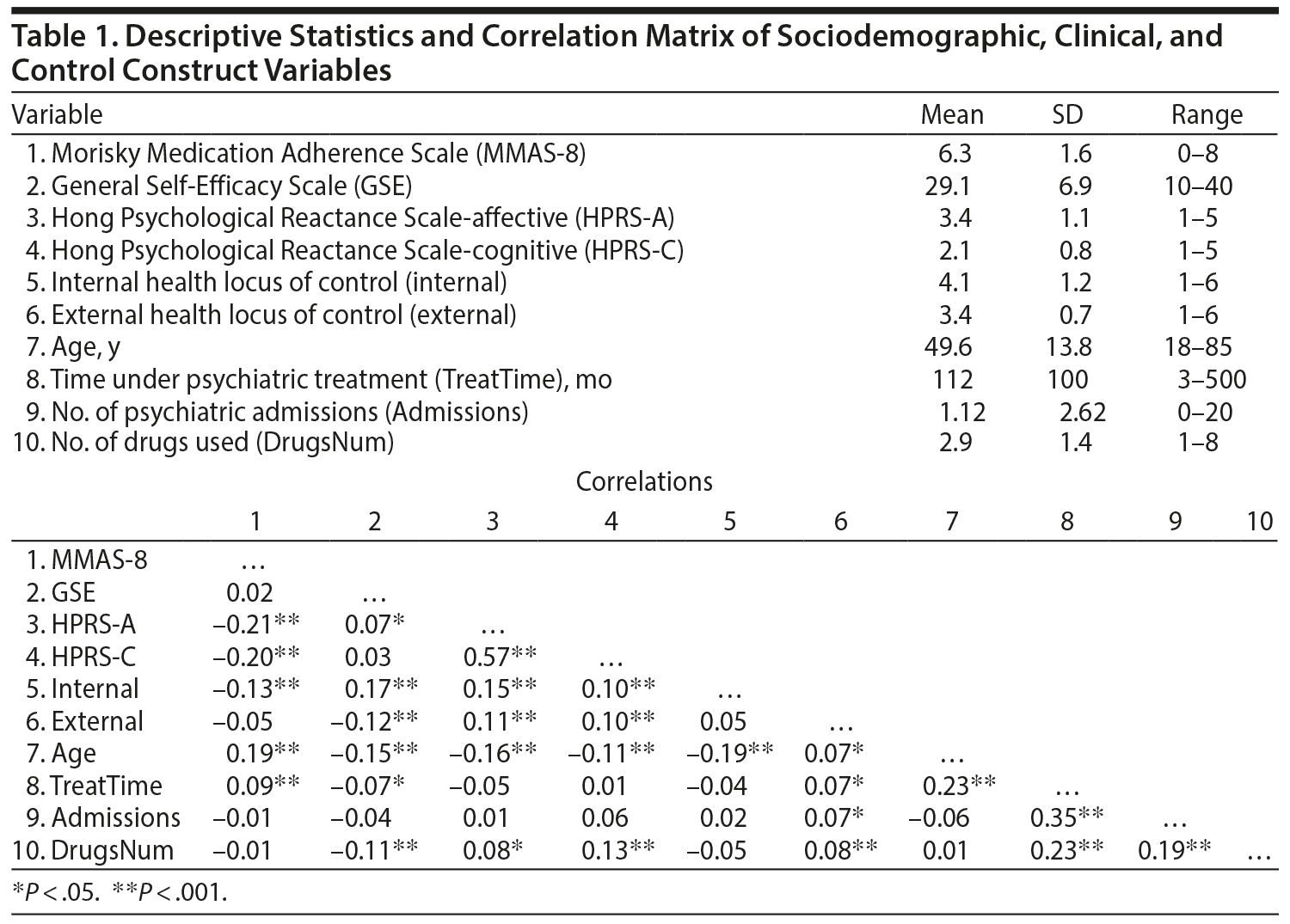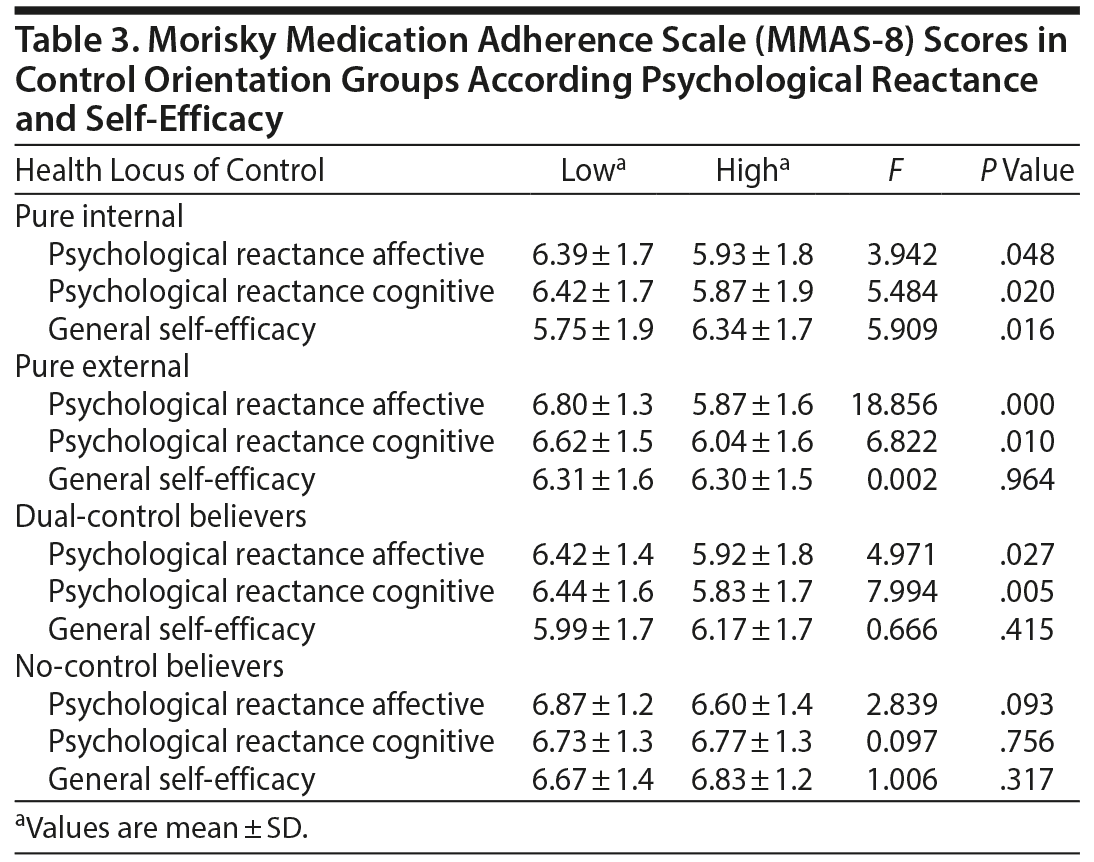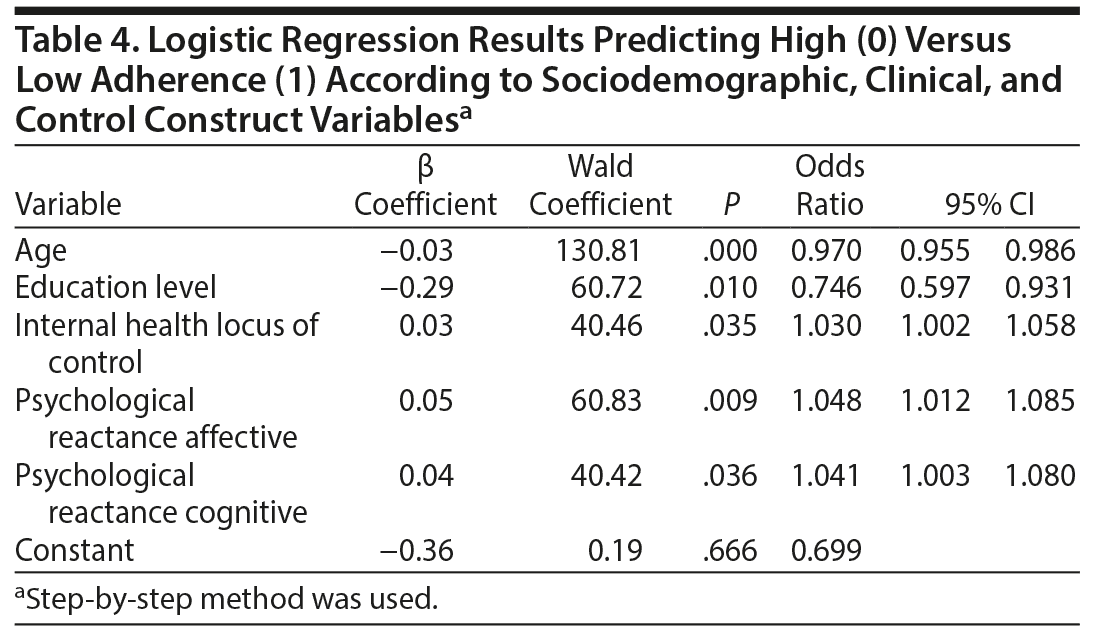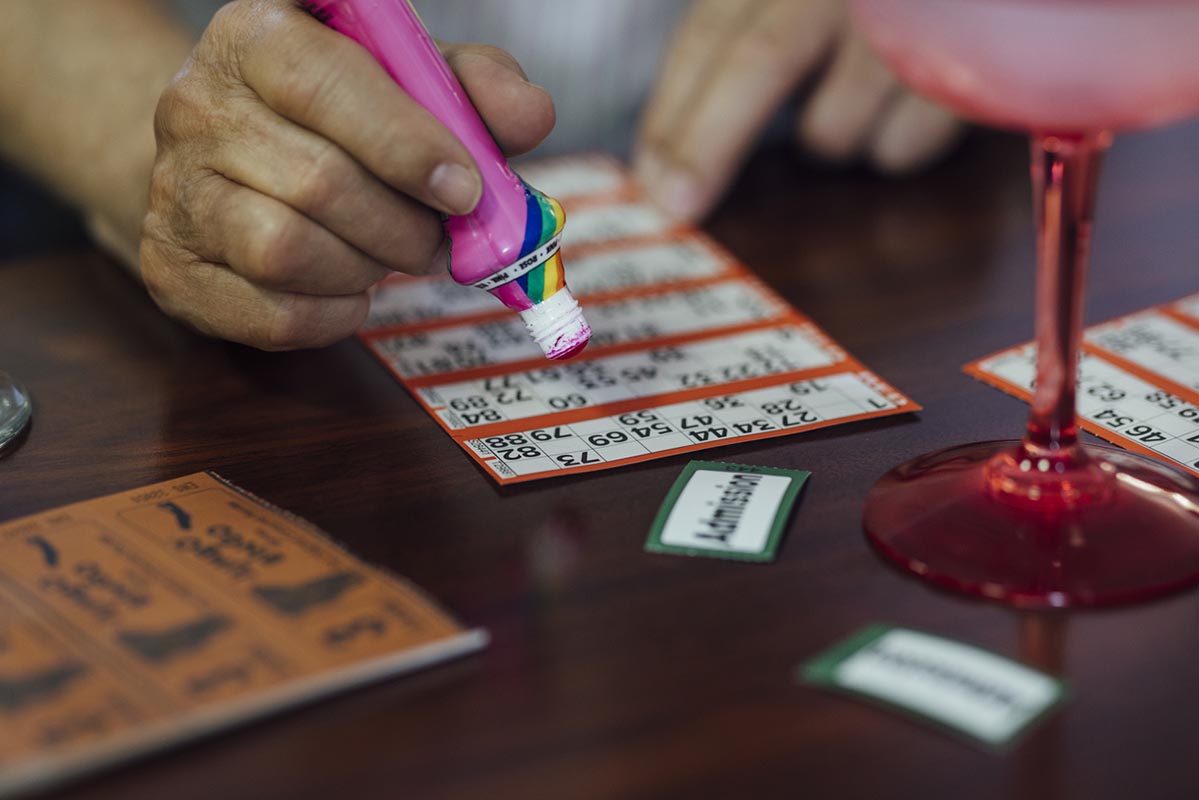Objective: To examine the role of perceived health control variables in psychiatric patients’ adherence to prescribed treatment.
Methods: Cross-sectional study including 966 consecutive adult Spanish psychiatric outpatients attended from October 2013 to April 2014 at community mental health services in the Canary Islands. Diagnoses were made using the ICD-10 criteria. Participants completed the 8-item self-report Morisky Medication Adherence Scale, Form C of the Multidimensional Health Locus of Control Scale, the General Self-Efficacy Scale, and the Hong Psychological Reactance Scale at their regular clinic visit. Sociodemographic and clinical variables were gathered. Logistic regression analyses were conducted to determine the predictive power of the variables studied.
Results: The present findings confirm that the control beliefs variables studied are related to psychiatric patients’ self-reported adherence and support the dual health control hypothesis. This hypothesis specifies that the balance between internal and external health control beliefs (ie, the extent to which individuals attribute their health to their own actions or to external agents such as doctors, significant other people, or chance) is related to adherence to prescribed treatment. Results from logistic regression analysis indicated that health control beliefs interact with psychological reactance, exerting their effects on patients’ adherence (12.8% of the variance explained and 64.2% of patients were correctly classified). It was found that low scores on both internal and external health control beliefs (P < .001) as well as low level of affective (P < .001) and cognitive (P < .001) psychological reactance best predicted self-reported adherence.
Conclusions: The knowledge of control constructs beliefs in psychiatric outpatients could allow the psychiatrist to predict noncompliance, monitor patient progression more closely, and individualize patient education in an effort to increase treatment adherence in patients who have difficulties adhering to treatment plans.
See free commentary by Santiago
A Promising Step Forward in Our Understanding of Treatment Adherence in Psychiatric Care

ABSTRACT
Objective: To examine the role of perceived health control variables in psychiatric patients’ adherence to prescribed treatment.
Methods: Cross-sectional study including 966 consecutive adult Spanish psychiatric outpatients attended from October 2013 to April 2014 at community mental health services in the Canary Islands. Diagnoses were made using the ICD-10 criteria. Participants completed the 8-item self-report Morisky Medication Adherence Scale, Form C of the Multidimensional Health Locus of Control Scale, the General Self-Efficacy Scale, and the Hong Psychological Reactance Scale at their regular clinic visit. Sociodemographic and clinical variables were gathered. Logistic regression analyses were conducted to determine the predictive power of the variables studied.
Results: The present findings confirm that the control beliefs variables studied are related to psychiatric patients’ self-reported adherence and support the dual health control hypothesis. This hypothesis specifies that the balance between internal and external health control beliefs (ie, the extent to which individuals attribute their health to their own actions or to external agents such as doctors, significant other people, or chance) is related to adherence to prescribed treatment. Results from logistic regression analysis indicated that health control beliefs interact with psychological reactance, exerting their effects on patients’ adherence (12.8% of the variance explained and 64.2% of patients were correctly classified). It was found that low scores on both internal and external health control beliefs (P < .001) as well as low level of affective (P < .001) and cognitive (P < .001) psychological reactance best predicted self-reported adherence.
Conclusions: The knowledge of control constructs beliefs in psychiatric outpatients could allow the psychiatrist to predict noncompliance, monitor patient progression more closely, and individualize patient education in an effort to increase treatment adherence in patients who have difficulties adhering to treatment plans.
J Clin Psychiatry 2016;77(10):e1233-e1239
dx.doi.org/10.4088/JCP.15m09769
© Copyright 2016 Physicians Postgraduate Press, Inc.
aDepartment of Internal Medicine, Dermatology and Psychiatry and bPersonality, Assessment and Psychological Treatments, University of La Laguna, San Cristóbal de La Laguna, Canary Islands, Spain
cDepartment of Psychiatry, Queen’s University, Kingston, Ontario, Canada
*Corresponding author: Carlos De las Cuevas, MD, PhD, Department of Internal Medicine, Dermatology and Psychiatry, School of Medicine, Campus de Ofra s/n, 38071 San Cristóbal de La Laguna, Spain ([email protected]).
Psychiatric disorders are a growing public health concern worldwide: schizophrenia, mood disorders, substance abuse, and dementia contribute more to global disease burden than cancer or cardiovascular disease.1 Nonadherence to appropriately prescribed medications compromises the effectiveness of available treatments and interferes with recovery. Previous reviews have shown a great variability in psychotropic nonadherence rates (10%-77%), with mean rates of 35%-60%.2-5
Treatment adherence in psychiatric clinical practice is a multidimensional phenomenon determined by the interplay of several factors.6 In the context of patient-related factors, the study of the psychological processes from the health beliefs could be of relevance, increasing the knowledge about a patient’s adherence to treatment.7 In this same context of patient-related factors, utilizing the social-cognitive health model (covered in detail below) to study adherence reflects the difficulties of translating the evidence gathered from this perspective into actual psychiatric practice.8
Traditional health models emphasizing the role of control beliefs associated with healthy behaviors include the Health Belief Model,9,10 which is a social cognition model that attempts to explain health behaviors by focusing on the attitudes and beliefs of individuals. Self-efficacy is a central concept of the social-cognitive health model.11 This construct, from social-cognitive theory,11 reflects the extent to which individuals perceive themselves as capable of implementing the sequences of acts that are needed to fulfill some goal; it is regarded as a key determinant of success and has been linked to chronic illness adjustment.12,13 The theory of reasoned/planned behavior14,15 introduces the concept of perceived control behavior, which is similar to the self-efficacy construct.
According to these theories, the belief in one’s ability to exert control over the environment is an essential aspect of human nature; it is increasingly recognized as an important determinant of health and well-being.16,17 It has been argued that the perception of control is not only desirable but most likely a psychological and biological necessity.18 Control beliefs are one of a number of determinants of health behavior and outcomes.19,20 Psychiatric patients who believe they have control over their health behavior are more likely to engage in healthy behavior; thus, they are more likely to have better health outcomes, quality of life, and functioning.21-23 The most common approaches to understand control beliefs are the health locus of control, the self-efficacy, and the psychological reactance constructs.
The health locus of control construct, derived from the social learning theory,19 links the individual health behavior to external or internal factors. Health locus of control refers to the belief individuals have about who or what is the agent that determines their health. If persons believe that their own behaviors affect whether they stay healthy or recover from an illness, they are said to have an "internal" health locus of control orientation. On the other hand, beliefs attributing causation of health/illness to agents outside of the individual—such as other people, the environment, luck, or chance—are referred to as "external."24-26
Psychological reactance refers to the perception that our freedom to choose is being limited by others. It is an aversive motivational state that functions to restore an individual’s perceptions of autonomy in response to regulations or impositions that impinge on freedom and the said autonomy,27-29 particularly when individuals feel obliged to engage in a specific behavior (as patients can feel about specific prescriptions or treatment instructions by their physicians). Although initially investigated as a state phenomenon, it has become evident that individuals are likely to vary as regards their trait propensity to experience reactance.30
Because health behaviors are directly related to treatment compliance, these health control (and counter-control) variables can affect adherence to treatment. These psychological characteristics have not been jointly investigated until now in psychiatric outpatients. Thus, the objective of this study is to determine the associations among health control beliefs and adherence to prescribed treatment in psychiatric outpatients in a community mental health setting. We hypothesized that these control constructs, either by themselves or by interaction with each other, would be associated with psychiatric patients’ adherence to prescribed treatment.

- Low adherence to medication is prevalent in community samples. Adherence in this study was examined from a sociocognitive perspective.
- Fundamental issues for clinicians to consider when assessing adherence to treatment in psychiatric patients are whether the patients feel in control of their health and whether they prefer freedom to make their own decisions. Better attention should be given to these factors, which are typically ignored.
METHODS
Sample Recruitment
From October 2013 to April 2014, 1,100 consecutive psychiatric outpatients, of a basic health area of 135,000 inhabitants of the Canary Islands Health Service, seen in the Community Mental Health Services on the island of Tenerife (Canary Islands, Spain) were invited to participate in a cross-sectional study. Patients were eligible for inclusion in the study if they were aged 18 years and older and were diagnosed by their psychiatrists with psychiatric disorders using the International Classification of Diseases, Tenth Revision (ICD-10), coded as F20 (schizophrenia), F31 (bipolar affective disorder), F32-33 (depressive episode and recurrent depressive disorder), F40-48 (obsessive-compulsive disorder and other neurotic, stress-related, and somatoform disorders), and F60 (personality disorders). Prior to the consultation with their psychiatrist, participants received a full explanation of the study, after which they signed an informed consent document approved by the local clinical research ethics committee. Participants then filled out a brief sociodemographic survey and the questionnaires that integrate the study.
Measures
Sociodemographic characteristics and clinical variables. Age, sex, education level, time under psychiatric treatment (in months), number of different drugs used, and the number of psychiatric admissions, specified as voluntary or involuntary, were registered. Patients’ diagnoses were collected from their therapeutic recommendation sheets.
Instruments. The validated Spanish version of Form C of the Multidimensional Health Locus of Control Scale (MHLC-C)31,32 was used to assess patients’ perception about who or what controls their mental illness outcomes. The MHLC-C is an 18-item general purpose, self-report scale easily adapted for use with any medical or health-related condition to assess individuals’ beliefs on what influences their health. For this study, 2 health locus of control dimensions were assessed: internal and external health locus of control. The internal health control dimension assesses the degree to which patients believe their health is influenced by their behavior, whereas the external health control dimension measures the belief that fate/luck, health care professionals, or other significant people control their health status. High scores represent high levels of control beliefs in their corresponding dimensions.
The self-efficacy construct was assessed using the validated Spanish version of the General Self-Efficacy Scale (GSE).33,34 The GSE scale is a 10-item self-report scale that measures general self-efficacy as a prospective and operative construct. The GSE scale explicitly refers to personal agency, that is, the belief that our own actions are responsible for successful outcomes. The summary score ranges from 10 to 40, with highest scores indicating high self-efficacy.
Psychological reactance was assessed using the validated Spanish version of the Hong Psychological Reactance Scale (HPRS).35,36 The HPRS is a 14-item self-report questionnaire that was developed to measure individual differences in reactance proneness, that is, individuals’ trait propensity to experience psychological reactance.
Self-reported adherence to psychiatric medication prescribed was assessed using the validated Spanish version of the 8-item self-report Morisky Medication Adherence Scale (MMAS-8).37,38 Questions are formulated to avoid a "yes-saying" bias. Total scores on the MMAS-8 range from 0 to 8.
RESULTS
We recorded a high response rate of 79% resulting in a sample of 966 psychiatric outpatients. The 966 patients who agreed to participate in the study had a mean ± SD age of 49.6 ± 13.8 years (range, 18-87), and 62.9% were female. Concerning education level, 9.0% of patients could only read and write, 34.6% had completed primary studies, 37.2% had completed secondary studies, and 19.3% had a university degree. The primary diagnoses of respondents were schizophrenia (18.5%), bipolar disorder (12.2%), depressive disorders (47.7%), anxiety disorders (16.6%), and personality disorders (3.1%). The mean ± SD duration of treatment was 112 ± 100 months (range, 1-400). The mean ± SD number of psychotropic drugs used was 2.9 ± 1.4 (range, 1-8). Only 13.3% of the patients were taking monotherapy treatment, whereas 27.0% received 2 drugs, 25.5% received 3, 17.9% received 4, and 16.3% received 5 or more drugs. A quarter of the psychiatric outpatients self-reported a high level of adherence to their prescribed psychiatric drugs, while 46.8% self-reported medium adherence and 28.2% a low adherence.
Analysis of variance tests show significant differences in MMAS-8 scores and health control questionnaires scores according to patients’ gender, education level, and diagnoses. Men registered higher values in internal health locus of control (P < .000), cognitive psychological reactance (P = .010), and general self-efficacy (P = .020). A low education level was associated with low self-efficacy (P = .001), low psychological reactance (affective, P = .013; cognitive, P = .025), low internality (P = .001), high externality (P < .000), and medium adherence (P = .014). Patients with bipolar disorders self-reported higher adherence to prescribed treatment, and patients with personality disorders reported lower adherence. Patients with personality disorders registered the higher internal health locus of control scores, and patients with depressive disorders registered the lower scores. Patients with anxiety disorders reported the higher self-efficacy, and those with depressive disorders reported the lower self-efficacy.
Pearson correlations were carried out among level of adherence and perceived control variables. Table 1 summarizes the results obtained. As can be observed, internal and external health locus of control dimensions did not correlate with each other (P = .1). Internal health locus of control was negatively related to patients’ age (r = −0.19, P < .000) and adherence to prescribed treatment (r = −0.13, P < .000) and was positively related to general self-efficacy (r = 0.17, P < .000), affective psychological reactance (r = 0.15, P < .000), and cognitive psychological reactance (r = 0.10, P < .001). On the other hand, external health locus of control was positively related to patients’ age (r = 0.07, P = .029), time under psychiatric treatment (r = 0.07, P = .037), number of psychiatric admissions (r = 0.07, P = .026), number of drugs used (r = 0.08, P < .001), affective psychological reactance (r = 0.11, P < .001), and cognitive psychological reactance (r = 0.10, P < .001), whereas it was negatively related to general self-efficacy (r = −0.12, P < .001). Adherence to prescribed treatment was linked to low levels of internal health locus of control (r = −0.13, P < .001), low affective (r = −0.21, P < .000) and cognitive (r = −0.20, P < .000) psychological reactance, and with older ages (r = 0.19, P < .000) and longer treatments (r = 0.09, P < .001).
A second analysis was carried out to test whether the dual health control hypothesis was applicable to this clinical sample. Psychiatric outpatients were first classified according to their scores on the internal and external health locus of control subscales. Those scoring at or below the median score of 4.33 on the internal subscale of the MHLC-C were classified as low internals, whereas those scoring above this median score were classified as high internals. Similarly, those scoring at or below the median score of 3.42 on the external health locus of control subscale of the MHLC-C were classified as low externals and those scoring above the median score were classified as high externals. Following Stenström et al39 and Wu et al,40 participants were further grouped into (1) pure internals (n = 244, 25.3%), ie, those with high internal but low external health control beliefs; (2) pure externals (n = 200, 20.7%), ie, those with high external but low internal health control beliefs; (3) dual-control believers (n = 247, 25.6%), ie, those with high internal and external health control beliefs; and (4) no-control believers (n = 275, 28.4%), ie, those with low internal and external health control beliefs. A 1-way analysis of variance was then conducted to determine whether self-reported adherence varied among these 4 health control orientation groups. Results showed that there were significant group differences on adherence to prescribed treatments (F22.961 = 9.165, P < .000), supporting the dual health control hypothesis. Figure 1 shows the distribution of the sample according to health locus of control dimension and self-reported adherence.
Analysis of variance tests were performed to assess the relationship of health locus of control with other control constructs. Table 2 displays the results registered.
We also tested whether health locus of control moderates the association of psychological reactance and self-efficacy with self-reported adherence. Pure internal, pure external, and dual-control-believer patients registered significant differences in self-reported adherence between high and low affective and cognitive reactant patients. Concerning general self-efficacy, only pure internal patients registered significant differences in adherence. Higher adherence was self-reported for no-control-believer patients with high self-efficacy and low affective and cognitive psychological reactance. Table 3 shows the results obtained.
Since many of the variables considered were related to patients’ self-reported adherence, a logistic regression analysis (step-by-step method) was also performed to determine their respective predictive power. Also, both sociodemographic and clinical/contextual variables usually associated with adherence were considered. In this case, only extreme adherence (high vs low) was considered. Variables were entered in the following sequence: the sociodemographic and contextual variables were put in the model first when testing the control construct variables; next, health control variables were entered. A final model with 5 variables predicting adherence was found. This model explained 12.8% of the variance of self-reported adherence, and 64.2% of patients were correctly classified. Detailed results are summarized in Table 4. Only 2 sociodemographic variables (age and education level) attained significance participation, both in the same sense: older patients and patients with higher education level were more adherent. When internal locus of control and reactance scales were entered into the equation as control variables, both more internal and reactant patients were less adherent. Table 5 shows a glossary of terms from the social cognition literature used in this article.
DISCUSSION
To our knowledge, this large, community psychiatry-based survey is the first to explore the associations among the main perceived control constructs (health locus of control, self-efficacy, and psychological reactance) and adherence to treatment in psychiatric outpatient care. As hypothesized, health locus of control, general self-efficacy, and psychological reactance beliefs are intimately related to psychiatric patients’ self-reported adherence.
Concerning health locus of control, the results obtained support the dual health control hypothesis.39 Those psychiatric patients with low internal and external health control beliefs (no-control believers) self-reported the higher adherence to treatment, while patients with high internal and high external health control beliefs (dual-control believers) informed the lower one.
Although it was once thought that internal and external beliefs were at opposite ends of a continuum,41 it is now understood that these 2 belief orientations are independent of one another. That is, a person might simultaneously hold internal and external beliefs about the locus of control of his or her health status.42,43 Following this assumption, previous studies have indicated that patients maintaining high internal health locus of control have been associated with greater medication adherence in the treatment of hypertension,44 renal dialysis,45 and diabetes.46 However, it is known that some psychiatric patients with internal beliefs may make a deliberate decision not to adhere to the treatment prescribed if they perceive themselves to be well or when the balance between their treatment regimens and their quality of life allows them to exercise the control of their own disease management. On the other hand, existing research47 suggests that in medical situations in which little personal control is possible and in patients suffering from certain chronic diseases, an external health locus of control may be advantageous. Moreover, other studies45,48-51 have noted greater levels of adherence in those who rely on family members and health professionals. Patients who believed that it was important to follow doctors’ instructions and those who had faith in the benefits of the treatment were more likely to adhere to treatments. Nevertheless, a psychiatric patient with high external health locus of control may be less likely to comply with his/her psychiatric treatment, as he or she believes the course of disease is uncontrollable and attributes advances or declines in health to natural remission or progression of disease.
An alternative point of view regarding this controversy considers types of "controllers."39,40 According to our results, (pure) internal patients are more adherent to treatment than (pure) external patients. But these levels are lesser compared with no-control-believer patients. The interpretation of these findings is complex, but there is an idea that any perception of control is a source of doubts about treatment compliance, either because patients do not trust themselves or because they do not trust others (as in their physicians). The data that dual-control believers are the patients with lower adherence can be considered as support for this idea.
Regarding psychological reactance, our study found a negative correlation between affective and cognitive dimensions of psychological reactance and self-reported adherence. We believe, with Fogarty,52,53 that psychological reactance assessment permits integration of many of the seemingly disparate and/or contradictory findings evidenced in the field of treatment adherence and may afford professionals new opportunities for improving patient compliance.
Considering general self-efficacy, our results are in line with previous studies54-56 that indicate that this psychosocial factor impacts adherence to treatment and therefore could play a role in the clinical outcome. Its measurement can be utilized to predict intention to change and to decide on interventions aimed at increasing self-care.57
The interaction among belief in health locus of control, reactance, and self-efficacy initially shows those relationship patterns, especially for reactance: for pure internal believers, pure external believers, and dual-control believers, there is more adherence to treatment in patients less reactant (affective and cognitive) and (for pure internal) in patients with higher levels of self-efficacy. These interactions vanish when no-control-believer patients are considered. If we take into account the initial results (no-control-believer patients obtained higher levels of adherence), it can be stated that this kind of thought about control is a sufficient variable to explain adherence by which psychological reactance and self-efficacy variables lose their interaction role.
Limitations of this study include the fact that it was of a cross-sectional type, which restricts the possibility of causal conclusions and can only demonstrate associations. Another limitation is that data on adherence to medication and perceived control constructs questionnaires were self-reported and therefore carry the potential risk of misstatement or could involve response biases. The strengths of this study include the large number of psychiatric outpatients who agreed to participate in the study and the large number of sociodemographic, clinical, and perceived control variables included. Another strength of the current study is that regression analyses performed were controlled for the contribution of these variables.
The identification of nonadherent patients in clinical practice is one of the most relevant tasks that a mental health care provider has. The knowledge of control constructs, health locus of control, self-efficacy, and psychological reactance in psychiatric outpatients could allow the psychiatrist to predict noncompliance, monitor patient progression more closely, and individualize patient education in an effort to increase treatment adherence in patients who have difficulties adhering to treatment plans. Health-promoting or intervention programs should attend to people’s specific control beliefs, self-efficacy, and psychological reactance.
For example, internally oriented patients often have a particular need to make their own choices in treatment, being closely involved in these choices, and tend to respond more positively to nondirected approaches and to prefer situations in which they can assume responsibility and work independently. Externally oriented patients, in contrast, tend to rely on the health opinions provided by health care professionals, appear to be more positively influenced by structured approaches, and to prefer self-care activities with clear recommendations for the precautions recommended. Likewise, evidence for the role of self-efficacy and psychological reactance indicates that the most favorable conditions for encouraging psychiatric patients treatment adherence include lack of coercion during prescription, a positive relationship with the prescriber, verbal persuasion, information containing vicarious experience, involvement of the patient in treatment decisions, and, of course, a medication regimen that minimizes adverse effects.
Submitted: January 2, 2015; accepted September 23, 2015.
Online first: August 16, 2016.
Potential conflicts of interest: The authors declare no potential conflicts of interest.
Funding/support: None reported.
REFERENCES
1. Prince M, Patel V, Saxena S, et al. No health without mental health. Lancet. 2007;370(9590):859-877. PubMed doi:10.1016/S0140-6736(07)61238-0
2. Cramer JA, Rosenheck R. Compliance with medication regimens for mental and physical disorders. Psychiatr Serv. 1998;49(2):196-201. PubMed doi:10.1176/ps.49.2.196
3. Lacro JP, Dunn LB, Dolder CR, et al. Prevalence of and risk factors for medication nonadherence in patients with schizophrenia: a comprehensive review of recent literature. J Clin Psychiatry. 2002;63(10):892-909. PubMed doi:10.4088/JCP.v63n1007
4. Lingam R, Scott J. Treatment non-adherence in affective disorders. Acta Psychiatr Scand. 2002;105(3):164-172. PubMed doi:10.1034/j.1600-0447.2002.1r084.x
5. Perlick DA, Rosenheck RA, Kaczynski R, et al. Medication non-adherence in bipolar disorder: a patient-centered review of research findings. Clinical Approaches in Bipolar Disorders. 2004;3:56-64.
6. Sabaté E. Adherence to Long-Term Therapies: Evidence for Action. Geneva, Switzerland: World Health Organization; 2003.
7. Janz NK, Becker MH. The Health Belief Model: a decade later. Health Educ Q. 1984;11(1):1-47. PubMed doi:10.1177/109019818401100101
8. Proctor EK, Landsverk J, Aarons G, et al. Implementation research in mental health services: an emerging science with conceptual, methodological, and training challenges. Adm Policy Ment Health. 2009;36(1):24-34. PubMed doi:10.1007/s10488-008-0197-4
9. Becker MH. The Health Belief Model and personal health behaviour. Health Educ Monogr. 1974;2:324-508.
10. Rosenstock I. Historical origins of the Health Belief Model. Health Educ Behav. 1974;2(4):328-335. doi:10.1177/109019817400200403
11. Bandura A. Health promotion from the perspective of social cognitive theory. Psychol Health. 1998;13(4):623-649. doi:10.1080/08870449808407422
12. Bandura A. Self-efficacy: toward a unifying theory of behavioral change. Psychol Rev. 1977;84(2):191-215. PubMed doi:10.1037/0033-295X.84.2.191
13. Holden G. The relationship of self-efficacy appraisals to subsequent health related outcomes: a meta-analysis. Soc Work Health Care. 1991;16(1):53-93. PubMed doi:10.1300/J010v16n01_05
14. Ajzen I. The theory of planned behavior. Organ Behav Hum Decis Process. 1991;50(2):179-211. doi:10.1016/0749-5978(91)90020-T
15. Fishbein M, Ajzen I. Predicting and Changing Behavior: The Reasoned Action Approach. New York, NY: Psychology Press; 2010.
16. Miller SM. Controllability and human stress: method, evidence and theory. Behav Res Ther. 1979;17(4):287-304. PubMed doi:10.1016/0005-7967(79)90001-9
17. Thompson SC. Will it hurt less if I can control it? a complex answer to a simple question. Psychol Bull. 1981;90(1):89-101. PubMed doi:10.1037/0033-2909.90.1.89
18. Leotti LA, Iyengar SS, Ochsner KN. Born to choose: the origins and value of the need for control. Trends Cogn Sci. 2010;14(10):457-463. PubMed doi:10.1016/j.tics.2010.08.001
19. Wallston KA. Hocus-pocus, the focus isn’ t strictly on locus: Rotter’s social learning theory modified for health. Cognit Ther Res. 1992;16(2):183-199. doi:10.1007/BF01173488
20. Shapiro DH Jr, Schwartz CE, Astin JA. Controlling ourselves, controlling our world: psychology’s role in understanding positive and negative consequences of seeking and gaining control. Am Psychol. 1996;51(12):1213-1230. PubMed doi:10.1037/0003-066X.51.12.1213
21. Rosenfield S. Factors contributing to the subjective quality of life of the chronic mentally ill. J Health Soc Behav. 1992;33(4):299-315. PubMed doi:10.2307/2137310
22. Wagner EH, Austin BT, Davis C, et al. Improving chronic illness care: translating evidence into action. Health Aff (Millwood). 2001;20(6):64-78. PubMed doi:10.1377/hlthaff.20.6.64
23. Bengtsson-Tops A. Mastery in patients with schizophrenia living in the community: relationship to sociodemographic and clinical characteristics, needs for care and support, and social network. J Psychiatr Ment Health Nurs. 2004;11(3):298-304. PubMed doi:10.1111/j.1365-2850.2003.00718.x
24. Wallston KA, Strudler-Wallston B. Who is responsible for your health? The construct of health locus of control. In: Sanders GS, ed. Social Psychology of Health and Illness. Hillsdale, NJ: Erlbaum; 1982:65-95.
25. Wallston KA. Health locus of control beliefs. Patient Educ Newsl. 1982;5:56-57.
26. Wallston KA. Assessment of control in health-care settings. In: Steptoe A, Apples A, eds. Stress, Personal Control and Health. New York, NY: John Wiley & Son; 1989:85-105.
27. Brehm JW. A Theory of Psychological Reactance. New York, NY: Academic Press; 1966.
28. Brehm JW. Responses to loss of Freedom: A Theory of Psychological Reactance. Morristown, NJ: General Learning Press; 1972.
29. Brehm JW, Brehm SS. Psychological Reactance: A Theory of Freedom and Control. San Diego, CA: Academic Press; 1981.
30. Shen L, Dillard JP. Psychometric properties of the Hong Psychological Reactance Scale. J Pers Assess. 2005;85(1):74-81. PubMed doi:10.1207/s15327752jpa8501_07
31. Wallston KA, Stein MJ, Smith CA. Form C of the MHLC scales: a condition-specific measure of locus of control. J Pers Assess. 1994;63(3):534-553. PubMed doi:10.1207/s15327752jpa6303_10
32. De Las Cuevas C, Pe×±ate W, Betancort M, et al. What do psychiatric patients believe regarding where control over their illness lies? Validation of the multidimensional health locus of control scale in psychiatric outpatient care. J Nerv Ment Dis. 2015;203(2):81-86. PubMed doi:10.1097/NMD.0000000000000244
33. Schwarzer R, Jerusalem M. Generalized Self-Efficacy Scale. In: Weinman J, Wright S, Johnston M, eds. Measures in Health Psychology, A User’s Portfolio: Causal and Control Beliefs. Windsor, England: NFER-NELSON; 1995:35-37.
34. Bפןler J, Schwarzer R. Evaluación de la autoeficacia: adaptación espa×±ola de la escala de autoeficacia general. (Measuring generalized self-beliefs: a Spanish adaptation of the General Self-Efficacy Scale) Ansiedad Estres. 1996;2:1-8.
35. Hong SM, Faedda S. Refinement of the Hong psychological reactance scale. Educ Psychol Meas. 1996;56(1):173-182. doi:10.1177/0013164496056001014
36. De las Cuevas C, Pe×±ate W, Betancort M, et al. Psychological reactance in psychiatric patients: examining the dimensionality and correlates of the Hong Psychological Reactance Scale in a large clinical sample. Pers Individ Dif. 2014;70:85-91. doi:10.1016/j.paid.2014.06.027
37. Morisky DE, Ang A, Krousel-Wood M, et al. Predictive validity of a medication adherence measure in an outpatient setting. J Clin Hypertens (Greenwich). 2008;10(5):348-354. PubMed doi:10.1111/j.1751-7176.2008.07572.x
38. De las Cuevas C, Pe×±ate W. Psychometric properties of the eight-item Morisky Medication Adherence Scale (MMAS-8) in a psychiatric outpatient setting. Int J Clin Health Psychol. 2015;15(2):121-129. doi:10.1016/j.ijchp.2014.11.003
39. Stenström U, Wikby A, Andersson P, et al. Relationship between locus of control beliefs and metabolic control in insulin-dependent diabetes mellitus. Br J Health Psychol. 1998;3(1):15-25. doi:10.1111/j.2044-8287.1998.tb00552.x
40. Wu AM, Tang CS, Kwok TC. Self-efficacy, health locus of control, and psychological distress in elderly Chinese women with chronic illnesses. Aging Ment Health. 2004;8(1):21-28. PubMed doi:10.1080/13607860310001613293
41. Rotter JB. Generalized expectancies for internal versus external control of reinforcement. Psychol Monogr. 1966;80(1):1-28. PubMed doi:10.1037/h0092976
42. Wallston KA. Conceptualization and operationalization of perceived control. In: Baum A, Revenson T, Singer JE, eds. The Handbook of Health Psychology. Mahwah, NJ: Erlbaum; 2001:49-58.
43. Abbott J, Dodd M, Webb AK. Health perceptions and treatment adherence in adults with cystic fibrosis. Thorax. 1996;51(12):1233-1238. PubMed doi:10.1136/thx.51.12.1233
44. Hong TB, Oddone EZ, Dudley TK, et al. Medication barriers and anti-hypertensive medication adherence: the moderating role of locus of control. Psychol Health Med. 2006;11(1):20-28. PubMed doi:10.1080/14786430500228580
45. Poll IB, De-Nour AK. Locus of control and adjustment to chronic haemodialysis. Psychol Med. 1980;10(1):153-157. PubMed doi:10.1017/S0033291700039696
46. O’ Hea EL, Moon S, Grothe KB, et al. The interaction of locus of control, self-efficacy, and outcome expectancy in relation to HbA1c in medically underserved individuals with type 2 diabetes. J Behav Med. 2009;32(1):106-117. PubMed doi:10.1007/s10865-008-9188-x
47. Burish TG, Carey MP, Wallston KA, et al. Health locus of control and chronic disease: an external orientation may be advantageous. J Soc Clin Psychol. 1984;2(4):326-332. doi:10.1521/jscp.1984.2.4.326
48. Kirscht JP, Rosenstock IM. Patient adherence to antihypertensive medical regimens. J Community Health. 1977;3(2):115-124. PubMed doi:10.1007/BF01674233
49. Hartman PE, Becker MH. Non-compliance with prescribed regimen among chronic hemodialysis patients. Dial Transplant. 1978;7:978-985.
50. Porto TM, Machado DC, Martins RO, et al. Locus of pain control associated with medication adherence behaviors among patients after an orthopedic procedure. Patient Prefer Adherence. 2014;8:991-995. PubMed
51. De Las Cuevas C, Pe×±ate W, Sanz EJ. The relationship of psychological reactance, health locus of control and sense of self-efficacy with adherence to treatment in psychiatric outpatients with depression. BMC Psychiatry. 2014;14(1):324. PubMed
52. Fogarty JS. Reactance theory and patient noncompliance. Soc Sci Med. 1997;45(8):1277-1288. PubMed doi:10.1016/S0277-9536(97)00055-5
53. Fogarty JS, Youngs GA Jr. Psychological reactance as a factor in patient noncompliance with medication taking: a field experiment. J Appl Soc Psychol. 2000;30(11):2365-2391. doi:10.1111/j.1559-1816.2000.tb02441.x
54. Christensen A, Wiebe J, Benotsch E, et al. Perceived health competence, health locus of control, and patient adherence in renal dialysis. Cognit Ther Res. 1996;20(4):411-421. doi:10.1007/BF02228042
55. Catz SL, Kelly JA, Bogart LM, et al. Patterns, correlates, and barriers to medication adherence among persons prescribed new treatments for HIV disease. Health Psychol. 2000;19(2):124-133. PubMed doi:10.1037/0278-6133.19.2.124
56. Molassiotis A, Nahas-Lopez V, Chung WY, et al. Factors associated with adherence to antiretroviral medication in HIV-infected patients. Int J STD AIDS. 2002;13(5):301-310. PubMed doi:10.1258/0956462021925117
57. Kavookjian J, Berger BA, Grimley DM, et al. Patient decision making: strategies for diabetes diet adherence intervention. Res Social Adm Pharm. 2005;1(3):389-407. doi:10.1016/j.sapharm.2005.06.0
Author Affiliations

Enjoy free PDF downloads as part of your membership!
Save
Cite









